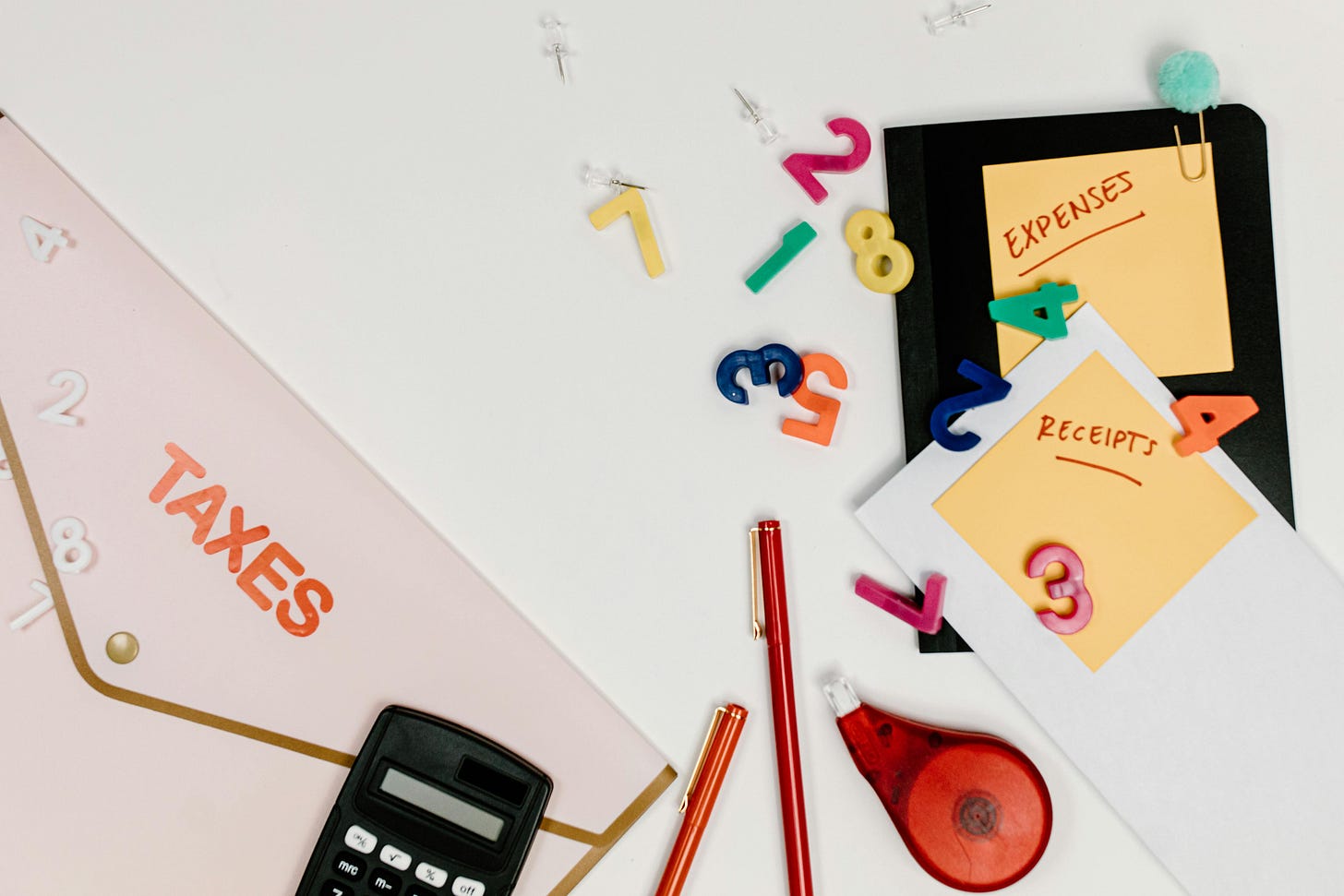Expense Reports & Reimbursement: Pay Yourself Back for Business-Related Expenses
Post #38: As a small business owner or freelancer, your business can pay you back for buying things that are business-related.
In this Substack, I will walk you through the process of starting, operating, maintaining, and — if needed — selling or closing your own small business.
Today, I am going to help you recover money spent on your business that should be deductible on your taxes as a business-related expense, and how to process a reimbursement to yourself.
In particular, I will cover:
What is an expense report
Why you should use expense reports to pay yourself back for business related expenses
Common business expense categories that can be captured in expense reports for reimbursement (with many examples)
⭐ Digital product expenses for people who work and sell products online
How to Reimburse yourself for business-related expenses that you paid for personally
Best practices for expense reporting and reimbursement
As a business owner, you’ll often find yourself purchasing items on behalf of your business using personal funds.
Whether it’s software, office supplies, or even a business meal, tracking these expenses and reimbursing yourself properly is important for maintaining accurate financial records.

👉 Subscribe to this Substack if you want to learn how to setup, operate, maintain, scale, etc… a small business. The Journey began with Post #1.
Also, be sure to check out these resources:
Bootstrap Your Business Workflow - a step-by-step guide with the links to all of the top daily posts that walk you through the process from scratch
BYB Book Recommendations - a collection of the best business books to help you on your entrepreneurial journey
BYB News Alerts! - urgent news and updates for self-employed and business owners - delivered to your inbox - so that you can be more prepared
BYB Documents - a repository of guidance for important business documents with instructions and guides to use them in your self-employment journey
What is an Expense Report?
An expense report is essentially a type of bill that the company owes.
When you purchase something personally (as an individual) for business use, your business owes you reimbursement for the expense.
In other words, your company owes a payment for a bill to you as an individual.
Creating a formal expense report ensures that your business records reflect all expenditures, even if the business didn’t pay for them directly at the time of purchase.
💡 Tip: When you are doing your business books, YOU can exist as a third party (individual or vendor), an employee of your company (W2, paid by your company via payroll with employee benefits), and the owner of your company (who can receive shareholder distributions and other owner-related benefits).
While this may seem confusing to be all three roles at the same time, this is simply how most businesses are able to keep business and personal finances separate, as I explained in a previous post on financial management.
I will cover these three roles in more details in an upcoming post, as well.
Subscribe or Follow Me to be notified when new topics are published!
Why Create Expense Reports?
Proper documentation and reimbursement for business expenses will save you from:
Missing out on legitimate deductions on your tax filings (and overpaying your taxes)
Under-reporting the true cost of running your business (which could be a problem when you are in need of a business loan or want to sell the company)
Losing track of personal funds spent on business needs (and having less money in your pocket to fund your life style)
By keeping detailed expense reports, you will ensure that your business can accurately track real operating costs, including the costs that you covered initially.
💡 Tip: Home office deductions are typically expenses paid for by YOU (as an individual) that qualify as business expenses that can be added to your recurring expense reports for reimbursement to YOU (as an individual).
Common Expense Categories for Expense Reports
According to the Internal Revenue Service (IRS), there are many types of eligible business expenses that can be deducted from your business income.
And, if you pay for these expenses personally, your company may be able to reimburse you for some or all eligible business-related expenses.
💡 Tip: as your business grows, you should do your best to pay for business-related expenses with a business checking account, business credit card, or other payment method through your business’s financial management so that you won’t have to reimburse yourself as much.
📌 This is NOT a comprehensive list of deductible business expenses.
For more information about expenses that are deductible for your business, be sure to check with the IRS website or ask your CPA, tax accountant, or a qualified professional.
1. Car and Truck Expenses
Mileage driven for business purposes (track with a log)
Gas, oil changes, and maintenance costs
Car insurance (business portion)
Parking fees and tolls
Lease payments or vehicle depreciation (if applicable)
💡 Tip: You can deduct mileage driven OR itemized expenses (gas, oil changes, etc,) but not both. For more information, go to the IRS website to read more about the business use of your car. In 2025, the standard vehicle mileage expense rate is 70 cents per mile!
2. Travel Expenses
Airfare, train, or bus tickets for business trips
Hotel and lodging costs
Business meals while traveling (subject to IRS meal deduction rules)
Baggage fees and travel insurance
Conference or seminar registration fees (these may also be “education” expenses, see below #8)
💡 Tip: check out the IRS website for more information and guidelines about business travel expenses and how to deduct them.
3. Meals and Entertainment
Client or business partner meals
Employee meals at offsite meetings
Meals during business travel
Snacks or beverages provided in the office
Holiday parties or employee appreciation events
💡 Tip: meals and entertainment expenses are not always 100% deductible, and some are not deductible at all. Be sure you check these guidelines from IRS before taking them as business expenses to avoid getting into trouble.
4. Office Expenses & Supplies
Paper, pens, printer ink, and office stationery
Postage, shipping, and courier services
Business phone and internet costs
Office furniture (desks, chairs, filing cabinets)
Cleaning supplies and office maintenance items
💡 Tip: some of these expenses can be deductible as a home office expense if you work exclusively from home. Read more on how to maximize your home office deductions.
5. Home Office Deductions (if applicable)
A portion of rent or mortgage interest (based on home office size)
Utilities like electricity, water, and heating
Business-use portion of home internet
Home office furniture and storage
Property insurance covering the office space
💡 Tip: this is a partial list - read more about maximizing your home office deductions.
6. Utilities & Telephone
Business landline or VoIP service
Business cell phone plan
Business internet service
Cloud-based phone services (like Zoom or Google Voice)
Mobile hotspot or additional data plans for business use
💡 Tip: Some of these may be deducted as home office expenses (see above #5).
7. Professional Services & Fees
Legal consultation and contract reviews
Accounting and tax preparation services
IT support and cybersecurity services
Business coaching or consulting fees
Professional memberships and industry certifications
8. Education & Training
Business-related books and online courses
Continuing education for professional licenses
Training seminars, workshops, and boot camps
Trade association conference fees
Certification exam costs
💡 Tip: Where appropriate, you may be able to deduct the cost of Substack subscriptions, like Jason Rowe’s Beyond the Firewall.
9. Software & Technology
Business software licenses (Microsoft Office, QuickBooks)
Website hosting and domain registration
Cloud storage services (Google Drive, Dropbox)
AI and automation tools (ChatGPT, Zapier, etc.)
Digital security and password management tools
💡 Tip: Where appropriate, you may be able to deduct the cost of digital products such as business document templates from Andi O.’s Bootstrap Your Business (this substack).
Subscribe or Follow Me to get notified when I launch the upcoming BYB Documents repository! 🚀
10. Advertising & Marketing
Social media advertising and sponsored posts
Google Ads and search engine marketing
Website development and maintenance
Business cards, flyers, and promotional materials
Podcast or influencer sponsorships
11. Employee & Contractor Expenses
Salaries and wages for employees (if applicable)
Independent contractor payments (1099 workers)
Payroll processing fees and employer taxes
Employee benefits and health insurance contributions
Performance bonuses and commissions
12. Insurance
Business liability insurance
Workers' compensation insurance (if applicable)
Professional malpractice or E&O insurance
Cybersecurity and data breach coverage
Business property insurance
💡 Tip: be sure to check out my post on Business Insurance!
13. Business Bank & Loan Fees
Business credit card annual fees
Business loan interest payments
Bank wire transfer fees
Merchant processing fees (PayPal, Stripe, Square)
Late fees or overdraft charges (if applicable)
14. Depreciation & Asset Purchases
Computers, printers, and business equipment
Vehicles used exclusively for business
Machinery and specialized tools
Office renovations and improvements
Large furniture purchases (capital expenditures)
💡 Tip: Learn more about Depreciation as a deductible home office expense!

What About Digital Product Expenses?
Since we are on a social media platform (yay, Substack!) and this is a relevant topic to many of you, let me focus on digital product expenses.
Here is a brief list of the types of expenses that you may be eligible to deduct from your taxable business income as a self-employed professional or business owner working online.
📌 Again, this is not a comprehensive list. Be sure to check the IRS website or talk with a qualified professional to ensure that you or your business are eligible.
E-books, templates, or downloadable business tools
Fees for publishing eBooks (Kindle, Amazon)
Transaction fees from sales of your digital products (Gumroad)
Online course platforms (Teachable, Udemy, etc.)
Paid stock photos, music, or video assets
AI tools or automation services (subscriptions, licensing, and other fees)
SaaS tools for digital product creation (Canva, Adobe Creative Cloud, etc.)
How to Reimburse Yourself for Business Expenses
Once you’ve documented your business expenses, the next step is getting reimbursed.
(1) Create an Expense Report
If you have accounting software, you can create a “Bill” for expense reporting.
Otherwise, you can use a simple spreadsheet or document that will allow for itemization of your expenses during a specified period (monthly is typical).
List each item purchased with these data:
date of purchase
total amount paid for each item
vendor, seller, or service provider name
Save and include digital or paper receipts or other proof of purchase (such as a Bill of Sale when no receipt was provided).
Categorize each expense appropriately (see above for common categories)
(2) Enter the Expense in Your Business Books
If using accounting software, your new Bill will appear as unpaid until you process the reimbursement payment.
Otherwise, be sure to add the total value of this expense report as an outstanding payment owed to you (as an individual, if you paid for these expenses personally).
(3) Issue the Reimbursement
This is the fun part!
Write a business check or process an online payment from your business banking account to YOU (as an individual and name yourself as the recipient) in the amount of the expense report total.
Be sure that this payment is deposited into your personal banking account, or the same account used to initially make the purchase (if possible). This will keep your accounting clean and deter any confusion about where the money went.
(4) Document the Payment (and store it in your records)
In your accounting software or general ledger, record the payment under business expenses.
Be sure to keep a copy of the reimbursement record for tax purposes.
Use this chronological paper receipt storage system to stay organized:
Print a paper copy of the expense report.
Add the printed expense report to the file folder.
Include all relevant paper receipts.
Best Practices for Managing Your Business’s Expense Reports
Here are some additional tips and considerations as you get more practice with running your own business.
Set a Regular Reimbursement Schedule
Avoid letting expenses pile up by processing expense reports and reimbursement monthly or quarterly.
Set a deadline for getting these done by the 10th of the following month, like most large companies do - you’ll thank yourself later!
❌ Don’t get too far behind! ❌
One year, I let myself get nine months behind on my expense reporting and suffered horribly with the effort of getting caught up. It took me longer to get caught up than staying current.
Keep All Receipts
Even if you track expenses digitally, saving receipts (paper or electronic) is essential in case of an IRS audit.
💡 Tip: Check out this post for more information about keeping your receipts:
Use Accounting Software
Tools like QuickBooks, Wave, or even a simple spreadsheet can help track and categorize expenses efficiently.
💡 Tip: I will dive deeper into accounting software in an upcoming post.
Subscribe or Follow Me to get notified when new posts are released!
Stay Within IRS Guidelines
Make sure every reimbursed expense is legitimately business-related to avoid tax issues.
When in doubt, check the IRS website, or talk with a qualified professional.
Due Diligence
Do your due diligence when you are capturing your business expenses, creating expense reports, and reimbursing yourself for business-related expenses.
I am an entrepreneur - not a tax professional or a CPA - so please keep in mind that your unique circumstances may be different from what I have captured here.
When uncertain or confused, it is best to consult an accountant or tax advisor to help you.
Next Steps
My next post is a Sunday Book Review on a book about productivity and procrastination to help you get motivated and get more of the important tasks done!
📕 Eat That Frog!: 21 Great Ways to Stop Procrastinating and Get More Done in Less Time
Author: Brian Tracy
Discover practical strategies to overcome procrastination and enhance productivity. Tracy emphasizes tackling the most challenging tasks first - referred to as "eating the frog" - to maximize efficiency and achieve personal and professional goals.
Continue the Journey with Post #39 —>









Funny! I literally did this last night for my February expenses. I haven't paid myself yet, but the expenses and payable to myself are captured!